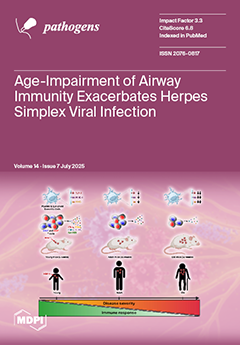Mycoplasma pneumoniae is a significant causative agent of atypical pneumonia in both children and adults. Timely and accurate diagnosis is crucial for appropriate patient management. Conventional methods for detecting
M. pneumoniae, such as culture and serology, exhibit several limitations regarding sensitivity, specificity,
[...] Read more.
Mycoplasma pneumoniae is a significant causative agent of atypical pneumonia in both children and adults. Timely and accurate diagnosis is crucial for appropriate patient management. Conventional methods for detecting
M. pneumoniae, such as culture and serology, exhibit several limitations regarding sensitivity, specificity, and turnaround time. In contrast, real-time PCR is considered the most reliable, rapid, and sensitive technique for the diagnosis of
M. pneumoniae infection. In this study, we adapted and validated an in-house real-time PCR assay for use on the fully automated Panther Fusion
® System. The validation process included two artificial samples, five external quality controls, and sixty-two patient samples. We evaluated the performance in terms of precision, sensitivity, linearity, and analytical sensitivity, comparing it to the original in-house assay. The Panther Fusion
® System demonstrated a broad dynamic range (16–1.6 × 10
7 copies/reaction), a robust correlation (94%) with the in-house assay, and comparable sensitivity (46 copies/mL vs. 25 copies/mL). The concordance between the in-house real-time PCR and the Panther Fusion
® System was 100% for both clinical samples and external quality controls. The adaptation of the test to the Panther Fusion
® System enabled the inclusion of
M. pneumoniae among the pathogens monitored for respiratory infection surveillance. Throughout 2024, we analyzed 2567 samples, with a peak positivity rate of 38% observed in August. These findings underscore the significance of employing the
M. pneumoniae diagnostic assay on the Panther Fusion
® System which proves valuable for the detection of
M. pneumoniae infections. This platform offers the advantages of increased automation and greater throughput potential compared to other platforms, enhancing the efficiency of respiratory pathogen detection in clinical settings.
Full article






